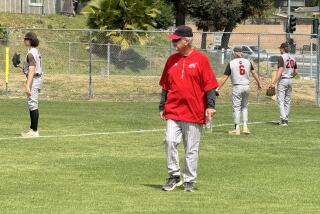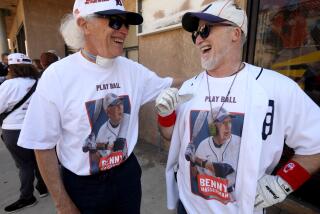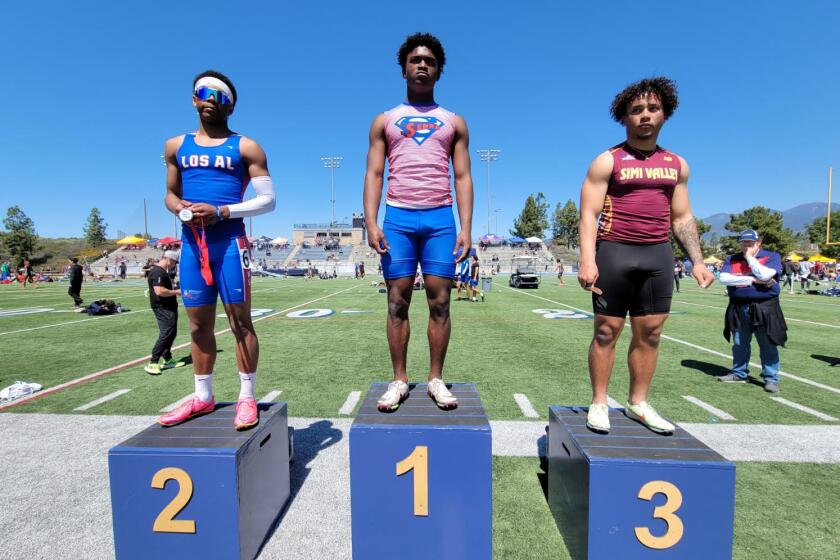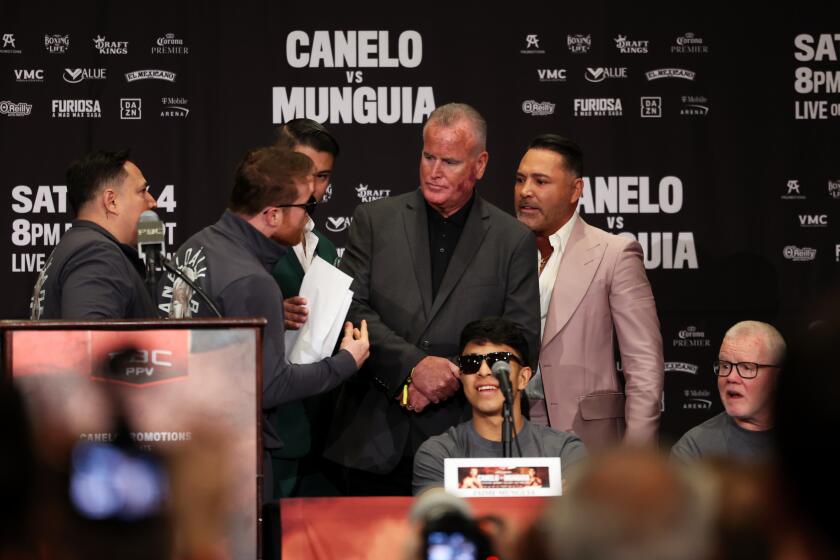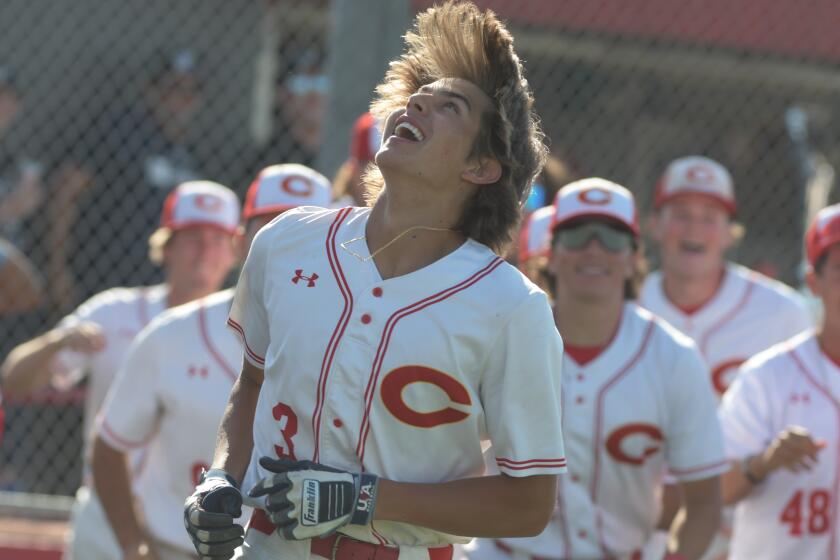Albert Pujols as a man among boys
Reporting from Kansas City, Mo. — It’s hard to fathom the trajectory of a ball hit from home plate at Liberty High to an air-conditioning unit on the roof of a two-story building behind the left-center field fence.
The fence is 375 feet from home. It’s another 50 feet up an embankment to the building. The metal air-conditioning unit is about 20 feet in from the edge of the roof.
And Albert Pujols hit one up there?
Yes he did — as an 18-year-old high school junior.
“The thing just went and went and went, and then you heard this, ‘Bong!’” recalled Dave Fry, Pujols’ coach at Fort Osage High in Independence, Mo. “I thought, ‘Jiminy, did he hit a ball that far?’ It had to be 485-490 feet.”
Like the famous Ted Williams shot marked by a single red seat deep in Fenway Park’s right-field bleachers, the Liberty homer is a part of Pujols lore.
It’s just one of many legendary shots on a Pujols’ power trip that began on the scraggly fields of the Dominican Republic, blossomed in the nation’s heartland, took a detour this winter to Anaheim and probably will end amid the lush, rolling hills of Cooperstown, N.Y., home to baseball’s Hall of Fame.
Marty Kilgore, Pujols’ coach at Maple Woods Community College in Kansas City, remembers a majestic 1999 shot Pujols hit at Highland College in Kansas. The ball flew over the 375-foot sign in left-center, over a street behind the fence and off a tree in the backyard of a house.
“It had to be more than 500 feet,” Kilgore said. “Their coach still talks about it today.”
It’s tougher for Tony La Russa to single out a most prodigious Pujols blast. He was the St. Louis Cardinals manager for every one of Pujols’ 445 career big league homers and 18 postseason shots.
“There’s about 20 tied for first,” La Russa said. “It’s impossible to pick one.”
As for Pujols’ favorite, he didn’t say. Through his agent, he declined to be interviewed for this story.
When it comes to slugging, Pujols, now 32 and a strapping 6 feet 3, 230 pounds, has always been ahead of the curve. And the fastball, changeup and slider, for that matter.
He was deemed “a man among boys” in high school and junior college because of his imposing size and power, and after a rapid rise to the major leagues as a 21-year-old in 2001, he was just as dominant at baseball’s highest level.
In addition to those homers, Pujols had 2,073 hits, a .328 average, .420 on-base percentage and .617 slugging percentage in 11 seasons at St. Louis.
The first baseman won three National League most-valuable-player awards, a rookie-of-the-year award and led the Cardinals to World Series championships in 2006 and 2011. In December, he signed a 10-year, $240-million deal with the Angels, the third-largest contract in baseball history.
“In the conversation of the greatest players of all time,” La Russa said, “Albert is in there already.”
Yet, in 1999, despite Pujols’ Herculean feats, talent evaluators deemed 401 amateur players better. That’s how many were drafted before the Cardinals took Pujols, then a shortstop, in the 13th round.
“That’s 401 picks where we all have a little explaining to do,” said Cardinals General Manager John Mozeliak, the team’s scouting director in 1999.
One scout who has covered the Kansas City area for more than 30 years provided a frank assessment of a circa-1999 Pujols: “I didn’t think he could play.”
The scout, who spoke at a recent Maple Woods scrimmage, would talk about Pujols only if his name wasn’t used. His current club doesn’t allow him to speak to reporters.
“First, there was his age — a lot of us thought he was older than he claimed,” the scout said. “He could really juice a fastball, but he couldn’t handle the slider away. Plus, he was athletic, but not highly athletic. There was a question about what position he’d play.
“I missed, as a lot of scouts did, on his makeup and work ethic, OK? That’s my fault. I’ll take full blame for that. … The one thing I learned from Albert is, I never walk away from raw power with a fastball. That will play.”
Kilgore, who took over as coach at Maple Woods the year Pujols arrived, cringes as he listens. Thirteen years later, it still bothers him that the outside perception of Pujols didn’t match the player he knew.
“What he’s had to deal with, from jealousy from parents and umpires to all these people questioning his age … he’s had to overcome a lot,” Kilgore said.
As for the draft-day snub? “I don’t think Albert has ever forgotten it,” Kilgore said.
While Pujols looked older, “He was as crazy and nutty as the other kids,” Fry said.
Phil Caldarella, who works in the Fort Osage district business office, said Pujols’ birth certificate was verified by officials from the NCAA and Major League Baseball. “People who were around him could tell he was just a teenage kid playing the game he loved,” he added.
Pujols grew up in the Dominican capital of Santo Domingo, and like many kids in the impoverished, baseball-crazed nation, he used sticks for bats and milk cartons for gloves.
His parents divorced when he was 3, and Pujols’ grandparents, Papi and America, became his primary caregivers. The couple had 10 of their own children who, though they were aunts and uncles, became like brothers and sisters to Pujols.
Albert, his father, Bienvenido, an acclaimed softball pitcher, and grandmother moved to New York City in the summer of 1996, when Albert was 16. But they didn’t stay long.
By the fall, after Albert witnessed a shooting at a grocery store, his grandmother relocated the family to Independence.
Pujols arrived at Fort Osage, a school of 1,400 students that draws from both suburban and rural areas in northeast Kansas City, speaking virtually no English. His first day, he sought out the baseball coach.
“Here’s this big, strong, good-looking kid just standing there smiling, saying he wants to play beisbol,” Fry said. “It was like a gift from the baseball gods.”
Pujols was placed in the sophomore class and tried out for the team that winter.
“I was on the gym floor hitting grounders, and one of my assistants said, ‘Come up here, you have to see this!’” recalled Fry, who retired in 2002. “We had a cage above the bleachers, and Albert was hitting shots that were tearing the end of the net out.”
Fry moved an all-state shortstop to third to make room for Pujols, who hit .471 with 11 homers and 32 RBIs to help Fort Osage win a state championship in 1997.
The next season, Pujols hit .600 with eight homers — including that Liberty shot — in just 33 at-bats. He was walked in 55 of his 88 plate appearances.
“Nobody would pitch to him,” said current Fort Osage Coach Chris Walker, an assistant in 1998. “He might be lucky to see one pitch to hit a game.”
At the urging of scouts who thought they’d get a better evaluation of Pujols at a higher level, Pujols left Fort Osage in the winter of his senior year and enrolled at Maple Woods, where he hit .466 with 22 homers and 76 RBIs in 1999.
Pujols hit a grand slam and turned an unassisted triple play in his junior college debut. Kilgore was equally impressed by Pujols’ dedication and maturity.
By then, Pujols was in a relationship with a woman he’d met at a Kansas City dance club. A single mother, she had a young daughter with Down syndrome. But instead of being a distraction, it seemed to fuel him.
“I’ve never been around anyone that driven,” Kilgore said. “He’d hit three times a day, before, during and after practice. He focused on baseball, his relationship. He’d get his rest and prepare himself.”
After rejecting the Cardinals’ initial offer of $10,000, Pujols headed 270 miles west to play for the Hays (Kan.) Larks in the wood-bat Jayhawk Collegiate League. He lived with the Larks’ longtime coach, Frank Leo, and his wife, Barb.
“He was all about business,” Frank recalled.
The Leos have hosted kids every summer for 32 years, and Barb says Pujols is “the neatest player we ever had. Usually, their room is a mess, with gear all over the place. Albert made his bed every day, kept everything neat and orderly. He was definitely mature for a 19-year-old.”
Barb could tell that Pujols’ girlfriend, Deidre, who visited several times that summer along with her daughter Isabella, was already a huge influence.
“Most kids would go out and party — Albert went out one night and danced up a storm, but that was it,” Barb said. “He wasn’t a big partier. A lot of that had to do with Deidre and Bella being in his life.”
Pujols hit .380 that summer, spraying line drives and homers to all fields. When they returned from night games, Barb would fix Frank and Albert something to eat, and the two would watch baseball highlights.
“One night I said, ‘Albert, some day I’m going to see you on all those ESPN highlight reels,’” Frank said. “He said, in broken English, ‘You really think so, Coach?’ We still talk about that.”
The Cardinals eventually upped their offer to $60,000, and Pujols signed that August. Less than four months later, on New Year’s Day 2000, he and Deidre were married.
Pujols played one minor league season, making the big league club in 2001 and quickly establishing himself as one of the premier hitters in the game.
He is the only major leaguer to post 10 consecutive seasons with a .300 average, 30 doubles, 30 homers and 100 runs batted in, falling just shy of 11 straight when he hit .299 with 99 RBIs in 2011.
“Had I seen this, I would have quit coaching and become his agent,” said Fry, the high school coach. “It makes you so proud. For two years I penciled his name in my lineup. Then, you hear people say he’s in the same class as Babe Ruth? Golly.”
Sitting in a booth at Applebee’s off Interstate 70 in Blue Springs, Mo., Fry marvels at the money Pujols has made — $104 million with the Cardinals — and will make with the Angels.
The Pujols Fry knew lived in the Hawthorne Place Apartments off Route 24 in Independence, a low-income, barracks-style complex behind a Quick Trip gas station and a Burger King where rent is often paid using federal housing vouchers.
Pujols’ ride back then? A beat-up, yellow Toyota with newspaper clippings hung on a string from the rearview mirror.
“I never thought I’d coach a kid who would make a quarter of a billion dollars,” Fry said. “He has upped the average yearly salary for Fort Osage graduates by many bucks.”
Those who coached and taught a younger Pujols are just as proud of the man he has become — a devoted husband and father of four (two girls, two boys), head of a foundation that ministers to people with Down syndrome and impoverished families in the Dominican, role model who doesn’t smoke or drink and has never tested positive for performance-enhancing drugs, loyal teammate, clubhouse leader and mentor.
“He’s a better man,” Kilgore said, “than he is a ballplayer.”
twitter.com/mikedigiovanna
More to Read
Get our high school sports newsletter
Prep Rally is devoted to the SoCal high school sports experience, bringing you scores, stories and a behind-the-scenes look at what makes prep sports so popular.
You may occasionally receive promotional content from the Los Angeles Times.
